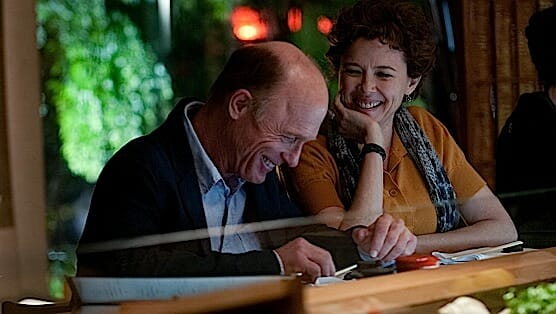Some might consider the premise behind Ari Posin’s The Face of Love as farfetched. Posin’s film chronicles the story of Nikki (Annette Bening), whose husband Garrett (Ed Harris) drowns during a romantic trip to Mexico. After a five-year period of morning, Nikki spots Garrett’s doppelgänger, Tom (also Ed Harris), at a museum and pursues a relationship with him.
While some seem to find the circumstances of the film a little hard to swallow, I think Posin’s film evokes Cinema’s long history of magical realism. Of course, the most obvious comparison is Vertigo, but also The Face of Love reminds me of Ingmar Bergman or Federico Fellini’s work. The film is not at all mad-cap, which it could of very well been. It’s subtler—absurd in the sense that a ridiculous premise is carried out to its realistic conclusion.
Posin poses an interesting question: What would happen if you met an exact replica of a deceased love one? What are the moral implications of pursing a relationship with someone just because they resemble someone who you once loved?
I’m not sure if the film answers any of these questions, but as the relationship between Bening and Harris blossoms, we’re left to make our own conclusions.
One of the strengths of the film is a tone that teeters between psychological thriller and beautiful love story. It’s hard not to sympathize with Bening. Nikki’s relationship to Tom is almost ideal, and when she loses him, she crumples.
At first, the prospect of a second chance with the man she loves seems too good to be true. He’s a sensitive artist, and as their relationship blooms, we root for things to work out. However, the deeper Nikki plunges into the relationship, the more delusional she becomes. She’s not interested in Tom for his unique characteristics, but rather for his similarities to her late husband.
She becomes very calculating in maintaining this delusion. She dresses Tom up like Garrett and prevents her daughter and friend, Roger (Robin Williams), from meeting him. She starts to take Tom to places that were special to her and Garrett. In one scene, she and Tom go to a restaurant she frequented with Garrett. When the wait staff mistakes Tom for her late husband, she doesn’t correct them.
If the film focused exclusively on Nikki’s neurosis, it would be difficult to care for any of the characters, but because Posin effectively demonstrates both the love Nikki had for her husband and the affection she develops for Tom, we become invested. As the relationship becomes more unhealthy and less sustainable, the tension builds in a way that wouldn’t be possible if we didn’t, in the end, want both the characters to achieve happiness.
Some have complained that the movie is too visually stylized, possessing a “lifestyle-catalog sheen” that creates a distance between the characters and the audience. I disagree.
I would argue that the metaphor in this circumstance is that Nikki is unhappy without her husband, despite the material perfection of her life. She has a create job, she lives in a beautiful world, but without Garrett, she’s incredibly unhappy. This raises the stakes and makes us care even more about the success of her relationship with Tom.
The movie, ultimately, is influenced by European cinema. Posin, who was born in Israel and spent a great deal of time abroad, borrows from European filmmakers. Fellini was more concerned with metaphor than he was with American realism. That seems to be Posin’s main concern, as well. It’s also where The Face of Love draws its strength.
Director: Arie Posin
Writer: Matthew McDuffie, Arie Posin
Starring: Robin Williams, Ed Harris, Annette Bening
Release Date: Mar. 7th, 2014
